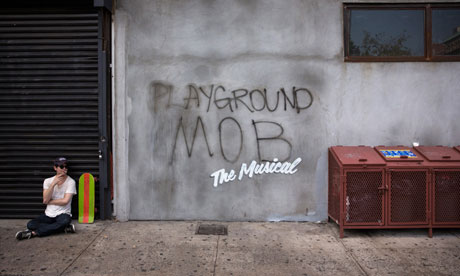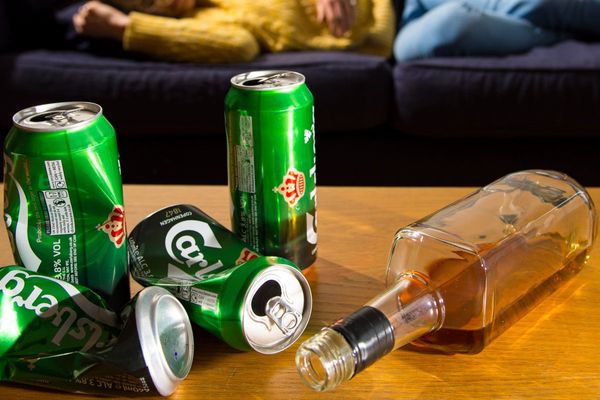He is the anonymous street art vigilante who uses the nondescript walls of cities to stage million-dollar exhibitions. In many places around the world, Banksy's graffiti art, with its strong political motifs, has become a cultural symbol and a community treasure. This month he is in New York, for what is expected to be a month-long residency featuring several new projects.
However, with great artistic acclaim and value comes a surge in commercialization. Many of Banksy's murals – prized greatly by art fans but even more so by private property owners – have been displaced and auctioned. In Los Angeles in August, a Banksy Flower Girl piece was removed from a gas station and put up for auction. The starting bid was $300,000. In February, a piece entitled Slave Labour disappeared under mysterious circumstances from a North London Poundland store, only to turn up in a Miami auction later that month, with an asking price of $700,000.
And then there are the Banksy pieces that have been put at risk simply because of their public nature. In Bristol, Gorilla in a Pink Mask was painted over by a building's new owners, who thought it was just a vandal's graffiti. In New York this week, Banksy's first mural was tagged by other artists within hours – before being erased entirely.

Regarding such threats of removal or damage to public art, cities are faced with two questions: should they protect the art? And if so, how? Banksy's murals are most often public art drawn – illegally, in some cases – on private property. This raises issues of ownership and preservation.
Amy Adler, professor of art law at New York University, suggests that "amendments to planning legislation are therefore a possible next step", in order to empower public authorities to preserve art in public spaces.
In Los Angeles, legal proceedings were brought when a large mural by the artist Ed Ruscha, on private land, was suddenly painted over. This was one of the few instances in which a work of public art was protected under federal visual artists rights regulations, preserving the work even if the ownership of the physical property changes.
Adler contends, however, that in Banksy's case, "for this to apply, Banksy himself would have to file for protection, which given his penchant for anonymity and illegality of his graffiti, he does not do".
When a mural has been put on a publicly owned space, local authorities have greater power to decide what to do – in some cases, they have taken on the task of preservation themselves. In 2006, Bristol city council polled residents when a Banksy image appeared on a public clinic: 97% said they wanted it to stay.
However not everybody agrees that the art should be preserved. In New York, authorities reacted less kindly to a Wall Street rat painting, critical of corporate America, and Let Them Eat Crack was ordered to be painted over. Banksy's Pulp Fiction bananas suffered the same fate after Transport for London claimed it employed "cleaners and not professional art critics".
"If we condone this then we might as well say that any kid with a spray can is producing art," Robert Davis, the chairman of Westminster Council's planning committee, said at the time. "To go and deface other people's property is graffiti. Just because he's famous doesn't give him that right."
Steven Thomas, a partner at the Irell & Manella law firm in LA, lends supports to this stance, as "the moral rights of Banksy are trumped by the fact trespass on the property took place. The building owner or local council can do as they wish".
Local governments find themselves powerless when the piece is on private property, where the retention depends on the owner. The recent removal of Slave Labour from a convenience store wall in London was a sting to the local community who regarded it as a source of pride to an otherwise degenerate area. The local Haringey Council protested that public works should not be for private enjoyment. It was eventually sold in London, though not reinstalled on the wall.

In 2011 John Webster of the University of Bristol, in Banksy's home town, suggested the addition public art to national historic registries. In the US, though, the National Register of Historic Places considers pieces of "historical interest or great artistic value", but only after at least 50 years. The UK only considers significant work after 15 years – but does protect it under a National Trust Lottery fund. Webster therefore proposes that an extension to criteria would have to be considered to incorporate protection for future generations.
Regarding the situation in the US, Phillipa Loengard, director at the Columbia Kernochan Center for Law and Arts, says: "The problem with the register is that the whole building would have to be listed resulting in more bureaucracy with developers and owners."
She cites a recently overturned ordinance by the Los Angeles city council that now allows street artists to paint murals in public.
"Cities should instead adopt something like the California Civil Code 989 which allows any community group to ask for protection by the building owner, if they fundraise for the preservation."
The legislation requires "recognized quality" and "substantial public interest" which is yet to be tested, but this could prove to be the way forward for many different communities.
Successful preservation has happened when local groups work directly with the artists and property owners to come to an agreement – something which is hard to do with a mysterious artist like Banksy.
Adler says: "The real problem we have is the rich irony of cultural preservation. The intention of the work is social change and vandalism. By trying to preserve it, it is contrary to the ethos of the work and subversive street culture."







